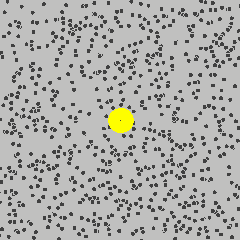模擬的大顆粒塵埃粒子碰撞到更小的粒子,而其以不同的速度在不同方向移動的布朗運動 。 粒子的立體空間進行布朗運動的示意圖。 布朗运动 (英語:Brownian motion )是微小粒子或者颗粒在流体 中做的无规则运动。布朗运动过程是一种正态分布 的独立增量连续随机过程 。它是随机分析 中基本概念之一。其基本性质为:布朗运动W(t)是期望为0、方差 为t(时间)的正态随机变量。对于任意的r小于等于s,W(t)-W(s)独立于的W(r),且是期望为0、方差 为t-s的正态随机变量。可以证明布朗运动是马尔可夫过程 、鞅过程 和伊藤过程 。
它是在西元1827年[1] 罗伯特·布朗 利用一般的顯微鏡 觀察懸浮於水中由花粉 所迸裂出之微粒時,發現微粒會呈現不規則狀的運動,因而稱它布朗運動。布朗運動也能測量原子 的大小,因為就是由水 中的水分子對微粒的碰撞產生的,而不規則的碰撞越明顯,就是原子愈小,因此根據布朗運動,定義原子的直徑為10-8 厘米。
定義 自1860年以來,許多科學家 都在研究此種現象,後來發現布朗運動有下列的主要特性:[2]
粒子的運動由平移 及轉移 所構成,顯得非常沒規則而且其軌跡幾乎是處處沒有切線。
粒子之移動顯然互不相關,甚至於當粒子互相接近至比其直徑小的距離時也是如此。
粒子越小或液體粘性越低或溫度越高時,粒子的運動越活潑。
粒子的成分及密度對其運動沒有影響。
粒子的運動永不停止。 對於布朗運動之誤解 值得注意的是,布朗运动指的是花粉迸出的微粒的随机运动,而不是分子的随机运动。但是通过布朗运动的现象可以间接证明分子的无规则运动。
一般而言,花粉 之直徑分布於30~50μm 、最小亦有10μm之譜,相較之下,水分子直徑約0.3nm (非球形,故依部位而有些許差異。),略為花粉的十萬分之一。因此,花粉難以產生不規則振動,事實上花粉幾乎不受布朗運動之影響。在罗伯特·布朗 的手稿中,「tiny particles from the pollen grains of flowers」意味著「自花粉粒中迸出之微粒子」,而非指花粉本身。然而在翻譯為諸國語言時,時常受到誤解,以為是「水中的花粉受布朗運動而呈現不規則運動」。積非成是之下,在大眾一般觀念中,此誤會已然根深蒂固。
花粉具備足夠大小,幾乎無法觀測到布朗運動。 在日本 ,以鶴田憲次『物理学叢話』為濫觴,岩波書店 『岩波理科辞典』[3] 湯川秀樹 『素粒子』、坂田昌一 『物理学原論(上)』、平凡社 『理科辞典』、福岡伸一著『生物與無生物之間』,甚至日本的理科課本等等,皆呈現錯誤之敘述。
直到1973年横浜市立大学 名誉教授 植物学 者岩波洋造在著書『植物之SEX‐不為人知的性之世界』中,點出此誤謬之前,鮮少有人注意。国立教育研究所物理 研究室長板倉聖宣在參與製作岩波電影『迴動粒子』(1970年)時,實際攝影漂浮在水中之花粉,卻發現花粉完全沒有布朗運動。遂於1975年3月,以「外行人與專家之間」為題,解說有關布朗運動之誤會。
愛因斯坦的理論 在1905年,爱因斯坦 提出了相关理论。他的理論有兩個部分:第一部分定義布朗粒子擴散方程式,其中的擴散係數與布朗粒子平均平方位移相關,而第二部分連結擴散係數與可測量的物理量。以此方式,愛因斯坦的理論可決定原子的大小,一莫耳 有多少原子,或氣體的克分子量。根據阿伏伽德罗定律 ,所有理想氣體在標準溫度和壓力下體積為22.414升,其中包含的原子的數目被稱為「阿伏伽德罗常数 」。由氣體的莫耳質量除以阿伏伽德罗常数等同原子量。
爱因斯坦论证的第一部分是,确定布朗粒子在一定的时间内运动的距离。[4] [來源請求] 14 次撞击。[5] [來源請求]
他把粒子在一个的空间中,把布朗粒子在一维方向上的运动增量 (x) 视作一个随机值(
Δ
{\displaystyle \Delta }
x, 并对其坐标进行变换,让原点成为粒子运动的初始位置)并给出概率密度函数
φ
(
Δ
)
{\displaystyle \varphi (\Delta )}
ρ
(
x
,
t
)
+
τ
∂
ρ
(
x
)
∂
t
+
⋯
=
ρ
(
x
,
t
+
τ
)
=
∫
−
∞
+
∞
ρ
(
x
+
Δ
,
t
)
⋅
φ
(
Δ
)
d
Δ
=
ρ
(
x
,
t
)
⋅
∫
−
∞
+
∞
φ
(
Δ
)
d
Δ
+
∂
ρ
∂
x
⋅
∫
−
∞
+
∞
Δ
⋅
φ
(
Δ
)
d
Δ
+
∂
2
ρ
∂
x
2
⋅
∫
−
∞
+
∞
Δ
2
2
⋅
φ
(
Δ
)
d
Δ
+
⋯
=
ρ
(
x
,
t
)
⋅
1
+
0
+
∂
2
ρ
∂
x
2
⋅
∫
−
∞
+
∞
Δ
2
2
⋅
φ
(
Δ
)
d
Δ
+
⋯
{\displaystyle {\begin{aligned}\rho (x,t)+\tau {\frac {\partial \rho (x)}{\partial t}+\cdots =\rho (x,t+\tau )={}&\int _{-\infty }^{+\infty }\rho (x+\Delta ,t)\cdot \varphi (\Delta )\,\mathrm {d} \Delta \\={}&\rho (x,t)\cdot \int _{-\infty }^{+\infty }\varphi (\Delta )\,d\Delta +{\frac {\partial \rho }{\partial x}\cdot \int _{-\infty }^{+\infty }\Delta \cdot \varphi (\Delta )\,\mathrm {d} \Delta \\&{}+{\frac {\partial ^{2}\rho }{\partial x^{2}\cdot \int _{-\infty }^{+\infty }{\frac {\Delta ^{2}{2}\cdot \varphi (\Delta )\,\mathrm {d} \Delta +\cdots \\={}&\rho (x,t)\cdot 1+0+{\frac {\partial ^{2}\rho }{\partial x^{2}\cdot \int _{-\infty }^{+\infty }{\frac {\Delta ^{2}{2}\cdot \varphi (\Delta )\,\mathrm {d} \Delta +\cdots \end{aligned}
第一行中的第二个等式是被
φ
{\displaystyle \varphi }
∂
ρ
∂
t
=
∂
2
ρ
∂
x
2
⋅
∫
−
∞
+
∞
Δ
2
2
τ
⋅
φ
(
Δ
)
d
Δ
+
(更 高 阶 的 项 )
{\displaystyle {\frac {\partial \rho }{\partial t}={\frac {\partial ^{2}\rho }{\partial x^{2}\cdot \int _{-\infty }^{+\infty }{\frac {\Delta ^{2}{2\,\tau }\cdot \varphi (\Delta )\,\mathrm {d} \Delta +{\text{(更 高 阶 的 项 )}
拉普拉斯算子之前的系数,是下一刻的随机位移量
Δ
{\displaystyle \Delta }
D
=
∫
−
∞
+
∞
Δ
2
2
τ
⋅
φ
(
Δ
)
d
Δ
{\displaystyle D=\int _{-\infty }^{+\infty }{\frac {\Delta ^{2}{2\,\tau }\cdot \varphi (\Delta )\,\mathrm {d} \Delta }
那么在 t 时刻 x 处的布朗粒子密度 ρ 满足扩散方程:
∂
ρ
∂
t
=
D
⋅
∂
2
ρ
∂
x
2
,
{\displaystyle {\frac {\partial \rho }{\partial t}=D\cdot {\frac {\partial ^{2}\rho }{\partial x^{2},}
假設在初始時刻t = 0時,所有的粒子從原點開始運動,擴散方程的解
ρ
(
x
,
t
)
=
ρ
0
4
π
D
t
e
−
x
2
4
D
t
.
{\displaystyle \rho (x,t)={\frac {\rho _{0}{\sqrt {4\pi Dt}e^{-{\frac {x^{2}{4Dt}.}
数学模型 定义 满足下列条件的鞅 我们称之为布朗运动
这个鞅是关于时间连续的。
他的平方减去时间项也是一个鞅。
(
M
t
)
{\displaystyle (M_{t})}
(
M
t
)
{\displaystyle (M_{t})}
(
M
t
2
−
t
)
{\displaystyle (M_{t}^{2}-t)}
其他定义 3000步的2维布朗运动的模拟。 1000步的3维布朗运动模拟。 一维的定义
一维布朗运动
(
B
t
)
t
≥
0
{\displaystyle \scriptstyle (B_{t})_{t\geq 0}
t 的一个随机过程,他满足 :
(独立增量)设时间t 和s 满足t > s ,增量
B
t
−
B
s
{\displaystyle \scriptstyle B_{t}-B_{s}
s 前的过程
(
B
u
)
0
≤
u
≤
s
{\displaystyle \scriptstyle (B_{u})_{0\leq u\leq s}
(稳定增量和正态性)设时间t 和s 满足t > s ,增量
B
t
−
B
s
{\displaystyle \scriptstyle B_{t}-B_{s}
t −s 的正态分布。
(
B
t
)
t
≥
0
{\displaystyle \scriptstyle (B_{t})_{t\geq 0}
t
↦
B
t
(
ω
)
{\displaystyle \scriptstyle t\mapsto B_{t}(\omega )}
通常假设
B
0
=
0
{\displaystyle \scriptstyle B_{0}=0}
等价定义
一维布朗运动
(
B
t
)
t
≥
0
{\displaystyle \scriptstyle (B_{t})_{t\geq 0}
t 的一个随机过程,他满足 :
(
B
t
)
t
≥
0
{\displaystyle \scriptstyle (B_{t})_{t\geq 0}
高斯过程 ,也就是说对于所有的时间列:
t
1
≤
t
2
≤
.
.
.
≤
t
n
{\displaystyle \scriptstyle t_{1}\leq t_{2}\leq ...\leq t_{n}
(
B
t
1
,
B
t
2
,
.
.
.
,
B
t
n
)
{\displaystyle \scriptstyle (B_{t_{1},B_{t_{2},...,B_{t_{n})}
(
B
t
)
t
≥
0
{\displaystyle \scriptstyle (B_{t})_{t\geq 0}
对于所有s 和t ,均值
E
[
B
t
]
=
0
{\displaystyle \scriptstyle \mathbb {E} [B_{t}]=0}
协方差
E
[
B
s
B
t
]
=
m
i
n
(
s
,
t
)
{\displaystyle \scriptstyle E[B_{s}B_{t}]=min(s,t)}
高维定义
(
B
t
)
t
≥
0
:=
(
B
t
1
,
B
t
2
,
.
.
.
,
B
t
d
)
t
≥
0
{\displaystyle \scriptstyle (B_{t})_{t\geq 0}:=\left(B_{t}^{1},B_{t}^{2},...,B_{t}^{d}\right)_{t\geq 0}
d 维布朗运动,只需满足
B
1
,
B
2
,
.
.
.
,
B
d
{\displaystyle \scriptstyle B^{1},B^{2},...,B^{d}
换句话说,d 维布朗运动 取值于
R
d
{\displaystyle \scriptstyle \mathbb {R} ^{d}
R
,
R
2
,
.
.
.
,
R
d
−
1
{\displaystyle \scriptstyle \mathbb {R} ,\mathbb {R} ^{2},...,\mathbb {R} ^{d-1}
Wiener测度的定义
设
C
(
R
+
,
R
)
{\displaystyle \scriptstyle {\mathcal {C}(\mathbb {R} ^{+},\mathbb {R} )}
R
+
{\displaystyle \scriptstyle \mathbb {R} ^{+}
R
{\displaystyle \scriptstyle \mathbb {R} }
(
Ω
,
T
,
P
)
{\displaystyle \scriptstyle (\Omega ,{\mathcal {T},\mathbb {P} )}
B
:
Ω
⟶
C
(
R
+
,
R
)
{\displaystyle B:\Omega \longrightarrow C(\mathbb {R} ^{+},\mathbb {R} )}
ω
↦
(
t
↦
B
t
(
ω
)
)
{\displaystyle \omega \mapsto \left(t\mapsto B_{t}(\omega )\right)}
Wiener测度 (或称为布朗运动的分布)设为
W
(
d
ω
)
{\displaystyle \scriptstyle W(d\omega )}
B 关于
P
(
d
ω
)
{\displaystyle \scriptstyle \mathbb {P} (d\omega )}
换句话说, W 是
C
(
R
+
,
R
)
{\displaystyle \scriptstyle {\mathcal {C}(\mathbb {R} ^{+},\mathbb {R} )}
A
⊂
C
(
R
+
,
R
)
{\displaystyle \scriptstyle A\subset {\mathcal {C}(\mathbb {R} ^{+},\mathbb {R} )}
W
(
A
)
=
P
(
(
B
t
)
t
≥
0
∈
A
)
{\displaystyle W(A)=\mathbb {P} ((B_{t})_{t\geq 0}\in A)}
备忘
布朗运动是一种增量服从正态分布的萊維過程 。
这个定义可以帮助我们证明布朗运动的很多特性,比如几乎处处连续,轨迹几乎处处不可微等等。
我们可以利用二次变差的期望为时间来等价定义布朗运动。这个定义由Levy定理演化而来, 即: 轨迹连续且二次变差为
t
{\displaystyle t}
性质 布朗运动的轨道几乎处处不可微:对于任何
ω
∈
Ω
{\displaystyle \scriptstyle \omega \in \Omega }
t
↦
B
t
(
ω
)
{\displaystyle \scriptstyle t\mapsto B_{t}(\omega )}
协方差
E
[
B
s
B
t
]
=
m
i
n
(
s
,
t
)
{\displaystyle \scriptstyle \mathbb {E} [B_{s}B_{t}]=min(s,t)}
布朗运动具有强马氏性: 对于停时 T ,取条件
[
T
<
∞
]
{\displaystyle \scriptstyle [T<\infty ]}
(
B
t
T
)
t
≥
0
:=
(
B
T
+
t
−
B
T
)
t
≥
0
{\displaystyle \scriptstyle (B_{t}^{T})_{t\geq 0}:=(B_{T+t}-B_{T})_{t\geq 0}
(
B
s
)
0
≤
s
<
T
{\displaystyle \scriptstyle (B_{s})_{0\leq s<T}
它的Fourier变换 或特征函数 为
E
[
e
i
u
B
t
]
=
e
−
t
u
2
2
{\displaystyle \scriptstyle \mathbb {E} \left[e^{iuB_{t}\right]=e^{-{\frac {tu^{2}{2}
布朗运动关于时间是齐次的: 对于s > 0,
(
B
t
+
s
−
B
s
)
t
≥
0
{\displaystyle \scriptstyle (B_{t+s}-B_{s})_{t\geq 0}
(
B
u
)
0
≤
u
≤
s
{\displaystyle \scriptstyle (B_{u})_{0\leq u\leq s}
-B 是一个布朗运动。
(稳定性) 对于c > 0,
(
c
B
t
c
2
)
t
≥
0
{\displaystyle \scriptstyle \left(cB_{\frac {t}{c^{2}\right)_{t\geq 0}
(时间可逆性)
(
t
B
1
t
)
t
>
0
{\displaystyle \scriptstyle \left(tB_{\frac {1}{t}\right)_{t>0}
t =0之外是布朗运动。
(常返性)只有1维和2维布朗运动是常返的: 如果
d
∈
{
1
,
2
}
{\displaystyle \scriptstyle d\in \{1,2\}
{
t
≥
0
,
B
t
=
x
}
{\displaystyle \scriptstyle \{t\geq 0,B_{t}=x\}
x
∈
R
d
{\displaystyle \scriptstyle x\in \mathbb {R} ^{d}
如果
d
≥
3
,
lim
t
→
∞
|
|
B
t
|
|
=
+
∞
{\displaystyle \scriptstyle d\geq 3,\,\,\,\lim _{t\rightarrow \infty }||B_{t}||=+\infty }
P
[
sup
0
≤
s
≤
t
B
s
≥
a
]
=
2
P
[
B
t
≥
a
]
=
P
[
|
B
t
|
≥
a
]
.
{\displaystyle \mathbb {P} [\sup _{0\leq s\leq t}B_{s}\geq a]=2\mathbb {P} [B_{t}\geq a]=\mathbb {P} [|B_{t}|\geq a].}
布朗运动的数学构造 利用Kolmogorov一致性定理 设
(
f
t
)
t
∈
R
+
{\displaystyle (f_{t})_{t\in {\mathbb {R} }_{+}
L
2
(
R
+
)
{\displaystyle L^{2}({\mathbb {R} }_{+})}
∀
(
u
,
v
)
∈
R
+
,
s
(
u
,
v
)
=
⟨
f
u
,
f
v
⟩
L
2
(
R
+
)
=
∫
R
+
f
u
(
x
)
f
v
(
x
)
d
x
{\displaystyle \forall (u,v)\in {\mathbb {R} }_{+}{\text{, }s(u,v)={\langle f_{u},f_{v}\rangle }_{L^{2}({\mathbb {R} }_{+})}=\int _{\mathbb {R} _{+}f_{u}(x)f_{v}(x)dx}
这列函数满足:
∀
k
∈
N
∗
{\displaystyle \forall k\in \mathbb {N} ^{*}
t
1
,
.
.
.
,
t
k
∈
R
+
{\displaystyle t_{1},...,t_{k}\in \mathbb {R} _{+}
(
s
(
t
i
,
t
j
)
)
1
≤
i
,
j
≤
k
{\displaystyle \left(s(t_{i},t_{j})\right)_{1\leq i,j\leq k}
利用Kolmogorov一致性定理,我们可以构造高斯过程
{
Y
t
}
t
∈
R
+
{\displaystyle \{Y_{t}\}_{t\in \mathbb {R} _{+}
m
{\displaystyle m}
s
{\displaystyle s}
当
(
f
t
)
t
∈
R
+
=
(
c
.1
1
[
0
,
t
]
)
t
∈
R
+
{\displaystyle (f_{t})_{t\in {\mathbb {R} }_{+}=\left({\sqrt {c}.1\!\!1_{[0,t]}\right)_{t\in \mathbb {R} _{+}
c
>
0
{\displaystyle c>0}
1
1
[
0
,
t
]
{\displaystyle 1\!\!1_{[0,t]}
[
0
,
t
]
{\displaystyle [0,t]}
s
(
u
,
v
)
=
c
∫
R
1
1
[
0
,
u
]
(
s
)
1
1
[
0
,
v
]
(
s
)
d
s
=
c.min
(
u
,
v
)
{\displaystyle s(u,v)=c\int \limits _{\mathbb {R} }1\!\!1_{[0,u]}(s)1\!\!1_{[0,v]}(s)ds={\text{c.min}(u,v)}
在这个情况下,矩阵
(
s
(
t
i
,
t
j
)
)
1
≤
i
,
j
≤
k
{\displaystyle \left(s(t_{i},t_{j})\right)_{1\leq i,j\leq k}
我们称一个高斯过程为 布朗运动 当且仅当均值为0,协方差为s。
c
=
V
a
r
(
B
1
)
{\displaystyle c=Var(B_{1})}
c
=
1
{\displaystyle c=1}
标准的布朗运动 .
利用随机过程 Donsker定理(1951)证明了逐渐归一化的随机游走弱收敛于布朗运动。
(
1
σ
n
(
∑
k
=
1
[
n
t
]
U
k
+
(
n
t
−
[
n
t
]
)
U
[
n
t
]
+
1
)
)
0
≤
t
≤
1
⟹
n
→
∞
(
B
t
)
0
≤
t
≤
1
{\displaystyle \left({\frac {1}{\sigma {\sqrt {n}\left(\sum _{k=1}^{[nt]}U_{k}+(nt-[nt])U_{[nt]+1}\right)\right)_{0\leq t\leq 1}{\underset {n\rightarrow \infty }{\Longrightarrow }(B_{t})_{0\leq t\leq 1}
其中(U n n ≥ 1) 独立同分布, 均值为0,方差为σ 的随机变量序列。
利用傅立叶级数 设2列独立的正态
N
(
0
,
1
)
{\displaystyle \scriptstyle {\mathcal {N}(0,1)}
(
N
k
,
k
∈
N
)
{\displaystyle \scriptstyle (N_{k},k\in \mathbb {N} )}
(
N
k
′
,
k
∈
N
)
{\displaystyle \scriptstyle (N'_{k},k\in \mathbb {N} )}
(
B
t
)
t
≥
0
{\displaystyle \scriptstyle (B_{t})_{t\geq 0}
B
t
:=
t
N
0
+
∑
k
=
1
+
∞
2
2
π
k
(
N
k
cos
(
2
π
k
t
−
1
)
+
N
k
′
sin
(
2
π
k
t
)
)
{\displaystyle B_{t}:=tN_{0}+\sum _{k=1}^{+\infty }{\frac {\sqrt {2}{2\pi k}\left(N_{k}\cos(2\pi kt-1)+N_{k}'\sin(2\pi kt)\right)}
为布朗运动。
参见 腳註
^ 部分紀錄為1828年。
^ 李育嘉. 漫談布朗運動 . [2012-12-14 ] . (原始内容存档 于2019-07-18). ^ 該辭典已於1987年所發行之第四版中修正。
^ BROWNIAN MOTION. : 5. ^ Feynman, R. The Brownian Movement . The Feynman Lectures of Physics, Volume I. 1964: 41-1 [2018-02-05 ] . (原始内容存档 于2021-02-14).
外部連結





















![\scriptstyle {\mathbb E}[B_{t}]=0](https://wikimedia.org/api/rest_v1/media/math/render/svg/3b1ce330b074c3c976f4ea1be45d3296b7027d8e)
![\scriptstyle E[B_{s}B_{t}]=min(s,t)](https://wikimedia.org/api/rest_v1/media/math/render/svg/cffb7841c8a42b9e045fa78c2ed14fec391cb715)
















![\scriptstyle {\mathbb E}[B_{s}B_{t}]=min(s,t)](https://wikimedia.org/api/rest_v1/media/math/render/svg/0c2960de156d232c7eb55b7e97c806720fabb51d)
![\scriptstyle [T<\infty ]](https://wikimedia.org/api/rest_v1/media/math/render/svg/2d6885b8b72ae1ad38319e88e7e957aa628444d3)


![\scriptstyle {\mathbb E}\left[e^{iuB_{t}\right]=e^{-{\frac {tu^{2}{2}](https://wikimedia.org/api/rest_v1/media/math/render/svg/4ab55235bec9cd31ec50cfa8bfccf871fab0569f)







![{\mathbb P}[\sup _{0\leq s\leq t}B_{s}\geq a]=2{\mathbb P}[B_{t}\geq a]={\mathbb P}[|B_{t}|\geq a].](https://wikimedia.org/api/rest_v1/media/math/render/svg/e41019e614a289a58287d418c67e9fa6804208de)









![(f_{t})_{t\in {\mathbb {R}_{+}=\left({\sqrt {c}.1\!\!1_{[0,t]}\right)_{t\in {\mathbb {R}_{+}](https://wikimedia.org/api/rest_v1/media/math/render/svg/22dc4d4d2b7105226701d051b942c22fe8ab2e72)

![1\!\!1_{[0,t]}](https://wikimedia.org/api/rest_v1/media/math/render/svg/78a6fbd7e256ad5badddb733d9e5e69964152958)
![[0,t]](https://wikimedia.org/api/rest_v1/media/math/render/svg/37d2d2fa44908c699e2b7b7b9e92befc8283f264)
![s(u,v)=c\int \limits _{\mathbb {R}1\!\!1_{[0,u]}(s)1\!\!1_{[0,v]}(s)ds={\text{c.min}(u,v)](https://wikimedia.org/api/rest_v1/media/math/render/svg/fe3733bb18c7af27a59fff85fe00649990a3be25)


![\left({\frac {1}{\sigma {\sqrt {n}\left(\sum _{k=1}^{[nt]}U_{k}+(nt-[nt])U_{[nt]+1}\right)\right)_{0\leq t\leq 1}{\underset {n\rightarrow \infty }{\Longrightarrow }(B_{t})_{0\leq t\leq 1}](https://wikimedia.org/api/rest_v1/media/math/render/svg/7da668dedd47db63b559871f6652a4458447db78)





